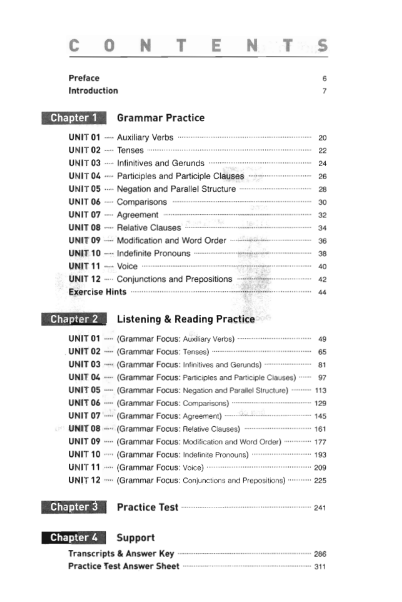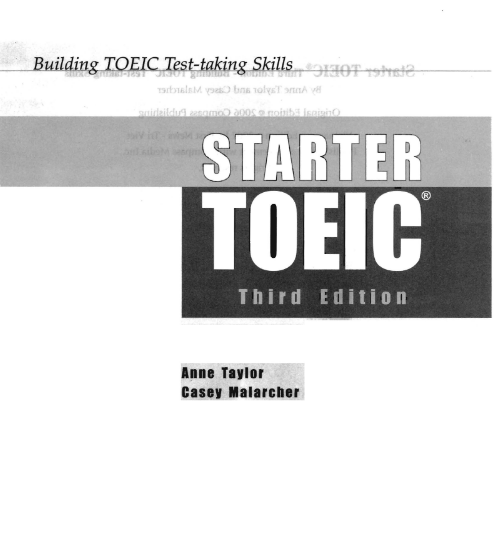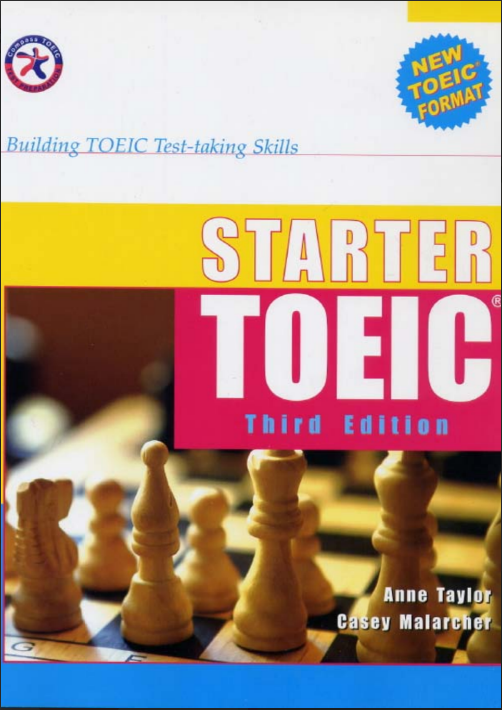


Preface Starter TOEIC, Third Edition is intended for beginning-level students of English who need to start preparation for the TOEIC. The book is designed to assist students through focused practice while developing familiarity with the format of the TOEIC. Chapter 1 Grammar Practice Units within the Grammar Practice chapter outline fundamental grammar points frequently tested on the TOEIC. Each unit begins with a brief explanation of the grammar target, including key points and particular structures of interest in the TOEIC. The units also provide short exercises based on the format of TOEIC grammar questions which allow students to practice their understanding of the grammar point. These exercises include incomplete sentence exercises and word form exercises. Chapter 2 Listening & Reading Practice Units within the Listening & Reading Practice chapter are designed as mini practice tests to familiarize students with the kinds of tasks they will encounter on the TOEIC. Additionally, all of the sections of each individual mini practice test are based on unified themes to support student acquisition of common vocabulary and phrases within a controlled framework. Students will also find that the grammar points outlined in Chapter 1 are recycled in corresponding units of Chapter 2 to reinforce recognition of correct usage of the grammar in natural contexts. For example, in Unit 1 of Chapter 2, students will hear through the listening tasks and read through the reading tasks a wide variety of auxiliary verbs (practiced in Unit 1) and context-all related to the theme of health. Chapter 3 Practice Test The Practice Test chapter provides students with a full-length practice test, including 100 listening test questions and 100 reading test questions. Chapter 4 Support The Support chapter includes reference materials related to the above chapters, including tape scripts for all listening tasks in each unit of Chapter 1 and in the practice test of Chapter 3, answer keys for each mini practice test in Chapter 2 and for the full-length test in Chapter 3, and a blank sample answer sheet for use when taking the full-length practice test. The simplified grammar and thematically based texts of Starter TOEIC, Third Edition provide beginning-level students with practice materials appropriate for building their test-taking skills without the frustration of encountering overly complicated vocabulary and grammar structures. Starter TOEIC, Third Edition will provide an excellent foundation for students starting preparation for the TOEIC test. — **Hình ảnh 2:** Introduction About TOEIC TOEIC stands for Test of English for International Communication. It is divided into two main sections: Listening and Reading. The Listening section tests the ability to understand spoken English. The Reading section tests the knowledge of grammar and vocabulary usage and the ability to read and understand short passages. There are a total of 200 questions on the TOEIC test, and the test lasts about 2 hours. All of the items are multiple-choice questions with three or four possible answers. The following chart outlines the organization of the test as of May 2006: Organization of the TOEIC Section I: Listening Test Part I: Picture Description 10 questions Part II: Questions and Responses 30 questions Part III: Short Conversations 30 questions Part IV: Short Talks 30 questions Listening Total 100 questions 45 minutes Section II: Reading Test Part V: Incomplete Sentences 40 questions Part VI: Incomplete Texts 12 questions Part VII: Reading Comprehension 48 questions Reading Total 100 questions 1 hour 15 minutes Grand Total 200 questions 2 hours — **Hình ảnh 3:** LISTENING TEST In this section of the test, you will have the chance to show how well you understand spoken English. There are four parts to this section, with special directions for each part. Part I: Picture Description The directions for Part 1 of the TOEIC appear on the test as follows: Directions: For each question in this part, you will hear four statements about a picture in your textbook. When you hear the statements, you must select the one statement that best describes what you see in the picture. Then find the number of the question on your answer sheet and mark your answer. The statements will not be printed in your test book and will be spoken only one time. Look at the sample below. [Image of a person with a laptop] Now listen to the four statements. (A) The woman is using a musical instrument. (B) The woman is typing on a computer. (C) The woman is playing a video game. (D) The woman is sitting behind the table. Sample Answer A B C D Statement (B), “The woman is typing on a computer,” best describes what you see in the picture. Therefore, you should choose answer (B). Tips * Preview the picture before the statements are read. Ask yourself, “Who?” “What?” “Where?” * Focus on the meaning of the statement as a whole. * Answer the question as quickly as possible. If you don’t know the answer, guess and begin previewing the next picture. Tricks * Incorrect answers may contain similar sounding words. e.g. The woman is tying at the table. * Incorrect answers may give wrong pronouns, numbers, and locations. e.g. He is typing at the table. / There are two typwriters. / The woman is sitting under the table. * Incorrect answers may include a correct word. e.g. The typewriter is for sale. / The woman is sitting with some friends. — **Hình ảnh 4:** Part II: Questions and Responses The directions for Part II of the TOEIC appear on the test as follows: Directions: You will hear a question or statement and three responses spoken in English. They will be spoken only one time and will not be printed in your test book. Select the best response to the question or statement and mark the letter (A), (B), or (C) on your answer sheet. Now listen to the four statements. You will hear: Good morning, John. How are you? You will also hear: (A) I’m fine, thank you. (B) I’m in the living room. (C) My name is John. Sample Answer A B C The best response to the question “How are you?” is choice (A), “I’m fine, thank you.” Therefore, you should choose answer (A). Tips * The first word of the question will help you to know what kind of answer is required. What, where, who, when, why, how-ask for information. * Questions that contain “or” and require a choice never have yes/no answers. * “Did you stay home or go out last night?” “I went to a movie.” * Sometimes you will hear a statement, not a question. However, it still requires an answer. “Thanks for dinner.” “You’re welcome.” Tricks * Pay attention to words that sound the same (homonyms). e.g. two, too, to * Look out for tag questions that are added to the end of statements. That movie was great, wasn’t it? * Watch out for indirect answers. Sometimes the answer is a yes/no question does not include the words “yes” or “no.” “Is there enough gas in the car?” “I just filled it yesterday.”
READING TEST In this section of the test, you have a chance to show how well you understand written English. There are three parts to this section, with special directions for each part. Part V Incomplete Sentences The directions for Part V of the TOEIC appear on the test as follows: Directions: A word or phrase is missing in each of the sentences below. Four answer choices are given below each sentence. Select the best answer to complete the sentence. Then mark the letter (A), (B), (C), or (D) on your answer sheet. Example: Because the equipment is very delicate, it must be handled with ——-. (A) caring (B) careful (C) care (D) carefully Sample Answer A B C D The sentence should read, “Because the equipment is very delicate, it must be handled with care.” Therefore, you should choose answer (C). TIPS * Don’t worry about spelling. Incorrect spelling is never an option in TOEIC answers. * Look at the words on either side of the blank. They can give you clues about what the correct answer is. * Read the whole sentence and understand the meaning before you answer. TRICKS * Watch out for answers with the wrong word form. e.g. drove, drives, driving * Watch out for words that use the same beginnings or endings. e.g. return, retire, reuse * Watch out for commonly misused words. e.g. affect/effect, lend/borrow — **Hình ảnh 2:** Part VI Incomplete Texts The directions for Part VI of the TOEIC appear on the test as follows: Directions: Read the texts on the following pages. A word or phrase is missing in some of the sentences. Four answer choices are given below each of these sentences. Select the best answer to complete the text. Then mark the letter (A), (B), (C), or (D) on your answer sheet. Example: As of June 15th, employees will be ——— to wear full company uniform whenever 1. (A) requiring (B) requirement (C) required (D) require Sample Answer A B C D 1. A B C D they are on company premises. This applies to all employees who work in areas of the 2. (A) considers (B) applies (C) works (D) implements building accessible by members of the public. The full uniform consists of a white shirt, green pants, and the company tie for men. The sentences should read “As of June 15th, employees will be required to wear full company uniform whenever they are on company premises. This applies to all employees who work in areas of the building accessible by members of the public.” Therefore, you should choose answers (C) and (B). TIPS * Remember that you are looking for the most appropriate word to fill in the blank. * Read the whole text, not just the words around the blank. Try to get the meaning of the text. TRICKS * Watch out for repetition and redundancy e.g. keep on continuing, finally at last * Watch out for words that don’t belong e.g. the apples they are fresh. * Pay attention to word form and verb tenses e.g. nice/nicely, had gone/has gone Part VII Reading Comprehension The directions for Part VII of the TOEIC appear on the test as follows: Directions: In this part you will read a selection of texts, such as magazine and newspaper articles, letters, and advertisements. Each text is followed by several questions. Select the best answer for each question and mark the letter (A), (B), (C), or (D) on your answer sheet. Read the following example. The Grenville Museum Of Technology is a “hands-on” museum, designed for people to experience science at work. Although this kind of museum may be fairly common nowadays, Grenville was the first of its kind in the U.S. Visitors are encouraged to use, test, and handle the various objects on display. Special demonstrations are scheduled for the first and second Wednesday of each month at 13:30. The museum is open Tuesday-Friday 12:00-16:30, Saturday 10:00-17:30 and Sunday 11:00-16:30. Admission is $2 for children and $3 for adults. At what times during the month can visitors see special demonstrations? (A) Every weekend (B) The first two Wednesdays (C) One afternoon a week (D) Every other Wednesday Sample Answer A B C D The reading selection says that the demonstrations are scheduled for the first and second Wednesdays of the month. Therefore, you should choose answer (B). TIPS * As with Part IV, pay attention to the introduction. It will tell you the number of questions and hint about the type of information in the questions. * As you read the passage, ask yourself, “Who is it for? Why was it written?” Then, go back to the passage and try to look for the answers to the questions. * First, glance quickly through the passage and read the questions. Then, go back to the passage and try to look for the answers to the questions. TRICKS * Many answers use information that appears in the passage. However, they may not directly answer the question. * With all sections of the TOEIC, watch out for similar sounding words, confusing numbers, wrong word forms, and words with similar meanings. * Don’t be confused by questions that follow these formats: e.g., which of the following is NOT mentioned in the reading? The text refers to all of the following EXCEPT: * Simply read the answer choices and find the one that is unfamiliar or incorrect.


